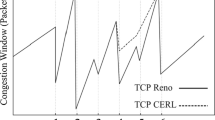Abstract
Wireless communication is more prone to random loss than wired communication because of noise and mobility. Over years researchers have developed TCP variants that do not decrease the send window when random loss arises. Years ago it was introduced TCP CERL algorithm that proved to present a high performance compared to other protocols. Here, we test CERL assuming two-way transmission of relatively heavy load and compare with TCP BIC, TCP NewReno, TCP Westwood+, TCP NewJersey and TCP Illinois. Simulation Results show that TCP CERL gains a 145%, 137%, 120%, 97% and 125% throughput improvement over New Reno, Bic, Westwood+, New Jersey and Illinois, respectively.










Similar content being viewed by others
References
Briscoe, B., Brunstrom, A., Petlund, A., Hayes, D., Ros, D., Tsang, I.-J., Gjessing, S., Fairhurst, G., Griwodz, C., & Welzl, M. (2014). Reducing internet latency: A survey of techniques and their merits. Communications Surveys Tutorials (pp. 1–1). IEEE.
Parvez, N., Mahanti, A., & Williamson, C. (2010). An Analytic Throughput Model for TCP NewReno. Proceedings of the IEEE/ACM TON, 18(2), 448–461.
Biaz, S., Vaidya, N. H. (2005). ‘De-randomizing’ congestion losses to improve TCP performance over wired-wireless networks. IEEE/ACM Transactions on Networking, 13(3), 596–608.
Foukalas, F., Gazis, V., & Alonistioti, N. (2008). Cross-layer design proposals for wireless mobile networks: A survey and taxonomy. IEEE Communications Surveys and Tutorials, 10(1), 70–85.
Dalal, P., & Dasgupta, K. (2012). TCP performance issues and related enhancement schemes over wireless network environment. International Journal of Advanced Research in Computer Science and Software Engineering, 2, 453–459.
Tian, Y., Xu, K., & Ansari, N. (2005). TCP in wireless environments: Problems and solutions. IEEE Communications Magazine, 43(3), S27–S32.
Wei, D. X., Jin, C., Low, S. H., & Hegde, S. (2006). FAST TCP: Motivation, architecture, algorithms, performance. IEEE/ACM Transactions on Networking, 14, 1246–1259.
Afanasyev, A., Tilley, N., Reiher, P., & Kleinrock, L. (2010). Host-to-host congestion control for TCP. IEEE Communications Surveys and Tutorials, 12(3), 304–342.
Gangadhar, S., Nguyen, T. A. N., Umapathi, G., & Sterbenz, J. P. (2013). TCP Westwood+ protocol implementation in ns-3. In Proceedings of the 6th International ICST Conference on Simulation Tools and Techniques (pp. 167–175), ICST (Institute for Computer Sciences, Social-Informatics and Telecommunications Engineering).
El-Ocla, H. (2010). TCP CERL: Congestion control enhancement over wireless networks. Wireless Networks, 16(1), 183–198.
Saedi T., & El-Ocla, H. (2019). Performance analysis of TCP CERL in wireless networks with random loss. In: IEEE Canadian conference of electrical and computer engineering (CCECE).
Wang, P., Jiang, H., & Zhuang, W. (2006). IEEE 802.11e Enhancements for Voice Service. IEEE Wireless Communications, 13(1), 30–35.
Contreras, J., Zeadally, S., & Guerrero-Ibanez, J. A. (2017). Internet of vehicles: Architecture, protocols, and security. IEEE Internet of Things Journal, 5(5), 3701–3709.
Yaqoob, S., Ullah, A., Akbar, M., Imran, M., & Shoaib, M. (2019). Congestion avoidance through fog computing in internet of vehicles. Journal of Ambient Intelligence and Humanized Computing, 10, 3863–3877.
Li, Y. T., Leith, D., & Shorten, R. N. (2007). Experimental evaluation of TCP Protocols for High-Speed Networks. IEEE/ACM Transactions on Networking., 15(1109), 1122.
Xu, L., Harfoush, K., & Rhee, I. (2004). “Binary increase congestion control for fast long-distance networks”, in Proc. Hong Kong: IEEE INFOCOM.
Xu, K., Tian, Y., & Ansari, N. (2005). Improving TCP performance in integrated wireless communications networks. Computer Networks, 47, 219–237.
Kaur, N., Umrao, S., & Gujral, R. K. (2014). Simulation based analysis of TCP variants over MANET routing protocols using NS2. International Journal of Computer Applications, 99(16), 975–8887.
Dunaytsev, R., Koucheryavy, Y., Harju, J. (2006). TCP NewReno throughput in the presence of correlated losses: The slow-but-steady variant. In: Proceedings of the 25th IEEE international conference on computer communications, INFOCOM.
Park, H.-S., Lee, J.-Y., & Kim, B.-C. (2011). TCP performance degradation of in-sequence delivery in LTE link layer. International Journal of Advanced Science and Technology, 37, 27–36.
Callegari, C., et al. (2014). A survey of congestion control mechanisms in Linux TCP. In Distributed Computer and Communication Networks (pp. 28–42)
Sathya Priya, S., & Murugan, K. (2015). Enhancing TCP fairness in wireless networks using dual queue approach with optimal queue selection. Wireless Personal Communications, 83(2), 1359–1372.
Sreekumari, P., & Chung, S. H. (2011). Tcp nce: A unified solution for non-congestion events to improve the performance of tcp over wireless networks. EURASIP Journal on Wireless Communications and Networking, 2011, 1–20.
Wu, J., & El-Ocla, H. (2004). TCP congestion avoidance model with congestive loss. In: IEEE international conference on networks.
Author information
Authors and Affiliations
Corresponding author
Additional information
Publisher's Note
Springer Nature remains neutral with regard to jurisdictional claims in published maps and institutional affiliations.
Rights and permissions
About this article
Cite this article
Saedi, T., El-Ocla, H. Improving Throughput in Lossy Wired/Wireless Networks. Wireless Pers Commun 114, 2315–2326 (2020). https://doi.org/10.1007/s11277-020-07477-x
Published:
Issue Date:
DOI: https://doi.org/10.1007/s11277-020-07477-x




